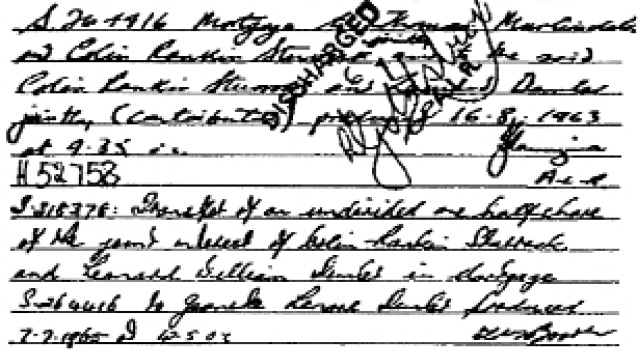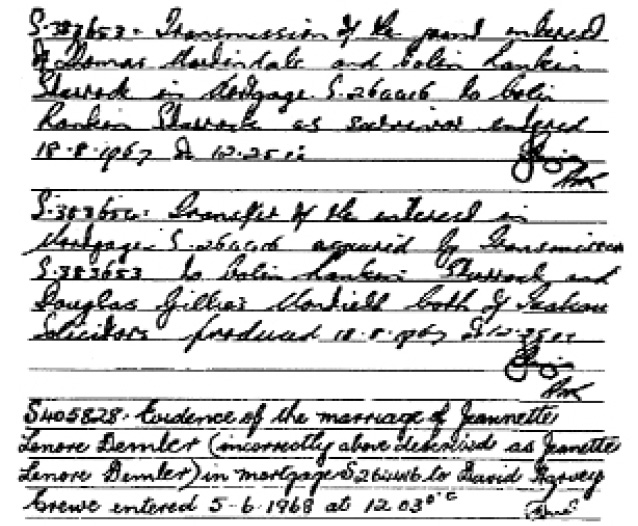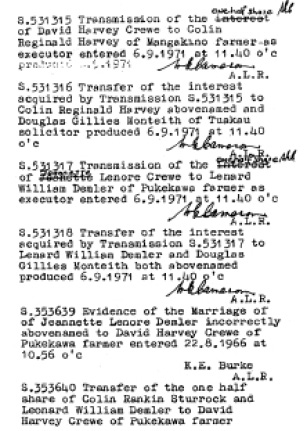Jeannette reached the age of 25 on 6 February 1965 and became eligible for her inheritance of the Chennells Estate of which she held half share with her sister Heather . . .
Jeannette and Heather had both received a generous bequest from the 1940 will of their uncle, Howard Chennells, who had left equal shares of his farm plus the balance of the trust funds, to the nieces on each reaching the age of 25 years.
It will be recalled that Howard’s farm (Section 7) was inherited in equal shares with his sister Maisie Demler from their father Newman Chennells in 1938. As mentioned earlier Howard had become the sole owner of Section 7 on 28 July the following year after Maisie had transferred her interests to her brother.
Section 7 was the original Chennells family farm and after the accidental death of Howard in 1950 the land was held in trust under a new title (Section 7 became Sections 13 & 14) but the farm itself was run by managers until Jeannette had reached the age of eligibility in February 1965.
However, it was five months before the transaction appeared on the Certificate of Title carrying the date of 7 July 1965: “Transfer of an undivided one half share of the residue to Jeanete (sic) Lenore Demler of Pukekawa, spinster”.
In its simplistic state, residue is any portion of the deceased’s estate that is not specifically identified. In this case the land was identified but the surplus from operating the farm and other ‘investments’ over the 15 years from Howard’s death in 1950 to the date of stipulated inheritance then collectively becomes the residue or balance of the estate.
According to Yallop, Jeannette not only received her half share of the farm but came into a residue amount something like $17,000 plus, wait for it, on the very same day (7 July 1965) she also received “an undivided one half share” in Sections 67 & 68 which until now has not appeared in any other documentation.
SECTIONS 67 & 68 EXPLAINED
These two sections of land, totalling 80 acres, could be relevant to solving this murder mystery but I believe the original purchase was to be a long term investment because of its close location to Sections 13 & 14 (soon to be the Crewe farm).
I believe its immediate use was to be a run-off for use by the family but it could also be seen as having more value as a kick-start to the land-locked area behind it which amounted to over 1000 acres.
The potential for owning Sections 67 & 68 was for the future development of a dairy farm or cropping, an option that Jeannette and Harvey would have been considering in their expansion plans.
The past history of the Chennells family in their “sharp” dealings with land were mild when compared with what was going to happen here (the body dumpings). According to the Certificate of Title for Sections 67 & 68 (situated on Frost Road adjacent to the banks of the Waikato River in the Onewhero Block) the plot will thicken.
MORTGAGE CHANGES HANDS
This land first came to the notice of the trustees of Howard Chennells estate when solicitor Colin Sturrock sold the idea to fellow trustee, Len Demler, as a potential investment.
Sturrock had earlier found himself as a surviving trustee to the former owner and on 16 August 1963 Len Demler was legally named as a joint and contributing trustee on behalf of Chennells Estate to hold the mortgage of Sections 67 & 68.
Barely two years later, as to her entitlement, Jeannette received her undivided one half share “of the joint interest of Colin Sturrock and Len Demler” in the mortgage. Effectively, at this point, Jeannette became the joint mortgage holder of sections 67 & 68 and also half owner of Sections 13 &14. Another hiccup came just over two years later with the death of a joint mortgage holder of Sections 67 & 68, Thomas Martindale whose interest was transferred to lawyer Colin Sturrock as survivor then at the same time to solicitors Sturrock & Monteith. The date was 18 August 1967.
The records were again tidied up on 5 June 1968 on the evidence of Jeannette’s marriage to Harvey Crewe then 15 months later, on 9 October 1969, the transfer of Sections 67 & 68 mortgage from Sturrock & Monteith to Jeannette Crewe (just 14 months before her murder).
UTILISING THE INHERITANCE
Time to wind the clock back a bit and consider if the aspirations of Jeannette and Harvey were going according to plan, a plan that is briefly touched on by David Yallop in his 1978 book Beyond Reasonable Doubt.
Originally their preferred choice, prior to their marriage, was to purchase a farm and settle in the Wairarapa but the cost was beyond their means so it made sense to take one step at a time and to first utilise Jeannette’s inheritance.
Yallop writes that Harvey was very conscious of the opportunity he was given to start up his own farm because of Jeannette’s circumstance although others were saying he had only married Jeannette for her money.
Yallop then goes on to confirm these thoughts after interviewing Jeannette’s friend Clare MacGee: “She told me that it would have been better if she had not had any money. Better for the marriage if they had had to rely on Harvey’s income. He resented the fact that she was wealthy. That’s why he worked so hard to justify himself. There were quite a number of people, I know for a fact, who thought he had married her for her money.”
Regardless of these claims Jeannette and Harvey were prepared to make a go of their life on the land and after being married on 18 June 1966 set about meeting the many challenges that were yet to raise their ugly heads.
YALLOP WAS MISTAKEN
David Yallop wrote on page 30 of his book that Harvey Crewe had bought Heather’s half share of the Chennell farm before his marriage to Jeannette but the Certificate of Title says differently.
Suspicions that something devious was going on was in finding a gap in the Certificate of Title entries where the name of Jeannette’s sister, Dianne Heather Demler, was not actually recorded as owning one half share of her uncle’s farm. Anyone with a suspicious mind would wonder what was going on.
Sure, there may be some logical explanation for this but I smell a rat.
HARVEY BUYS HEATHER’S HALF SHARE
Heather was eligible for her share in January 1967 but according to Yallop, Harvey Crewe had already purchased Heather’s half before marrying Jeannette in 1966 which enabled Heather, through the trustees, settlement of her estate ahead of time.
No dates were given by Yallop but the Certificate of Title suggests it was after the wedding as the date of the transfer is legally recorded as 22 August 1966 which was actually two months after the wedding.
In fact, the transfer shows Harvey Crewe actually purchasing the half share from the trustees, Colin Sturrock and Len Demler and NOT from Heather.
The obvious reason being that she had not yet reached the age of eligibility and of course a cynic may believe that more was going on than met the eye. For whatever reason, a mutual agreement had obviously been made with Heather as a means of allowing the transaction to go ahead.
As mentioned in an earlier chapter, Jeannette and Harvey had big plans for expansion after taking up her inheritance in 1965. She already had her half share in the Chennells Estate (original Section 7) and also Sections 67 & 68. Jeannette was also in line for her mother’s share in Len’s farm which prompted Harvey to express his desire to buy out his father-in-law.
History will show that sale did not happen so Harvey must have thought that Heather might be persuaded to cash in her share of the Chennells Estate. According to Yallop, Harvey did pay $45,000 for Heather’s share with a deposit of $9000 being paid in cash, “the rest by the way of a mortgage that he raised with State Advances.” (The Certificate of Title opposite shows the transaction did occur two months after their marriage).
The former Chennells Estate then became known as “The Crewe Farm”.
MARRIAGE “SLIGHTLY UN-NORMAL”
The marriage of Jeannette and Harvey started off on the right foot and while friends and neighbours saw them as keeping to themselves and not socialising, Jeannette’s sister Heather is quoted in Ian Wishart’s 2010 book The Inside Story as being so attached to each other in a way that was “slightly un-normal”.
Heather’s feelings were not explained but my gut was saying that it had to do with land and assets plus greed.
Readers may think I am obsessive over this line of thought but I am still keeping an open mind. Even at this early stage of her marriage Jeannette was a very wealthy young woman and destined to become very powerful particularly after her mother passed away less than four years in the near future.
To my mind, being slightly un-normal would come more from Harvey’s neck of the woods as he knew he was on to a good thing and there was no way he was going to upset ‘she who shall be obeyed!’
UNSOLVED INCIDENTS
The unsolved events of a burglary, the Crewe vehicle brake line cut and two fires over the next three years have not appeared on the list of priorities for the Police nor have mainstream news commentators applied any real importance to these crimes. However several authors have attempted to find factual links with perhaps Ian Wishart coming up with the most feasible in his book The Inside Story.
The most obvious reason for not connecting any dots was not being able to look far enough afield for suspects. There are people out there whose names have not yet appeared on the radar and to this day have no apparent connection with the double murders.
These unsolved crimes are definitely linked to the murders and were carried out initially as warnings which to me suggests feuding within the circle of those ‘in the know’.
Like others I’ve studied the dates leading up to that fateful day in June 1970 and have found connections worth investigating. Let’s look at the timeline of events:
Feb 1965: Jeannette reaches age of eligibility for inheritance
7 July 1965: Transfers of half share land interests to Jeannette
18 June 1966: Marriage of Harvey and Jeannette
22 Aug 1966: Harvey purchases Heather’s share
21 Jan 1967: Heather becomes eligible for her inheritance
18 June 1967: 1st wedding anniversary
29 July 1967: Crewe house burgled
29 Aug 1967: Harvey & Jeannette make their wills
18 June 1968: 2nd wedding anniversary
1 Dec 1968: Birth of Rochelle
7 Dec 1968: Fire in Crewe household
17 June 1969: Haybarn torched
18 June 1969: 3rd wedding anniversary
18 July 1969: Maisie Demler changes her will
26 Feb 1970: Death of Maisie Demler
17 June 1970: Harvey and Jeannette last seen alive
18 June 1970: Would have been 4th wedding anniversary
Not surprisingly, the dates do show up some coincidences with others having no visible relationship but all show that a person would have to have some knowledge of family affairs, would know detailed movements of the Crewes and most of all local knowledge as one would have to be within striking distance yet stay undetected.
The timeline shows the timing of the recent events being deliberate as they coincide with anniversaries but the date of the first burglary appears unrelated and would likely have been actioned as a first warning to back off.
COMMENTS FROM YALLOP AND WISHART
David Yallop says in his book Beyond Reasonable Doubt that the break in occurred during the evening while the Crewes were at the Demler farm.
Amongst the items the robber allegedly took included Jeannette’s personal effects such as handbag, her watch, two brooches, a sterling silver brush and comb set, a string of real pearls and her engagement ring. Because these items all belonged to Jeannette, this suggests to me that the burglary was committed by a woman. To top it off Harvey’s gun was not touched. Again it would be of no interest to a woman.
The Police were called and after assessing the crime scene were convinced it was not a genuine robbery as the house had not been searched. The target had been Jeannette’s dressing table and strangely money and other valuables remained in another dressing table. The robbery remains unsolved with the stolen items not recovered to this day.
Yallop had also interviewed family friend Beverly Batkin who said Harvey’s gun was there in the lounge. “I don’t know much about guns, but apparently it was quite a good one. That was not taken.” She was probably referring to Harvey’s shotgun, not a .22 rifle.
Author Ian Wishart was forced to dig deeper to back up his theory that Detective Len Johnston was actually the villain as he was there from day one in 1967 and was in a position to cover his tracks at any of the following crime scenes.
As the investigating officer Johnston was present for all the crimes on the Crewe’s property then again following the murders where he and Hutton were found to have planted evidence. Wishart ended up compiling an almost foolproof set of theories–that he admits to being entirely speculative–about the antics of Johnston and his amazing ability to manipulate evidence and people, despite the 2014 Police Review assessment that Wishart’s theory was fanciful. I don’t believe it though and there are no hard facts.
WHAT WILL HAPPEN NEXT?
The next warning to the Crewes followed the birth of their daughter Rochelle. Harvey returned home after visiting Jeannette in hospital to find the spare bedroom ablaze. At first, Harvey claimed the fire was caused by faulty wiring, a fact that could not be confirmed by an electrician and fire officer, but apparently he was later to concede that it could have been started deliberately.
If it was deliberate, the arsonist had to be familiar with the house but why go inside, why not light it from the outside where there was less chance of being caught red-handed? I believe the arsonist was inside the house for another reason but on the spur of the moment decided to send another warning that they meant business.
Without a doubt the second mysterious fire was planned. It occurred the evening before the Crewe’s third wedding anniversary and was another warning. This time the arsonist did not want to be seen near the house so torched their haybarn.
So far Police were called to all three crime scenes and while the offender/s were never found, Maisie Demler also wanted the matter kept quiet so asked the local newspaper editor not to publish any details.
My belief is that Maisie knew much more than she was letting on. She has been quoted as saying, “What are they going to do next?” She was careful not to expand on who “they” were but as the person who was very close to the Crewes she would have had good knowledge of any past indifferences or bitterness within the family.
And as scary as it may sound, I’m certain that the murderers were already planning for another showdown one year ahead on the day before the Crewe’s 4th wedding anniversary of 18 June 1970.
Their plans changed when Maisie died four months short of D-Day. The sh*t was starting to hit the fan and quite a few investors and family were to become disgruntled in a big way with the upcoming sale of Maisie’s estate.








Leave a Reply